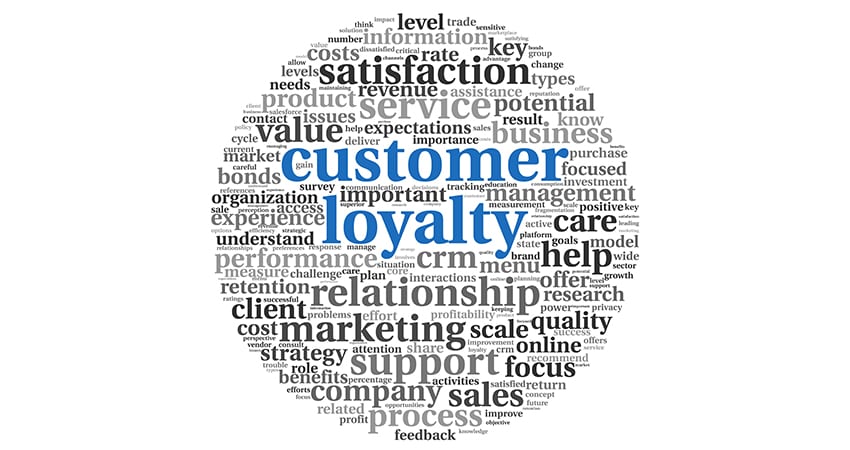If loyalty marketing was much hotter, customers would start charging brands for their business. Maybe they already do.
Businesses are tuning in to the fact that customers, not channels, are calling the shots now and it doesn’t take much for them to jump from one brand to another. It doesn’t have to be a mistake, it might just be that your brand doesn’t make them feel as special as a competitor does. Or maybe your customer experience feels clunky. Or maybe you just don’t make them feel like you really know, or care about, them. Then click – they’re gone.
Defining Loyalty for Profit
Customer loyalty is perhaps more important than it has ever been. But in the rush to create and nurture a fragile, fickle customer connection, too many brands are not eyeing their data clearly enough to build a loyalty program that is timely, cost-effective, and builds strong customer relationships. They are missing a step.
The smart move is to start with some solid working definitions. True customer loyalty is defined when a customer has a greater than 50% chance to purchase again in the future. Realize that for most brands, the percentage of repeat customers is far less than 50%, often closer to 25%, which means that most brands fail to achieve true customer loyalty despite touting ‘loyalty’ programs.
Where Does Your Business Fall in that Scale?
Until you have an answer to this question and more, a loyalty program will not save you. If three quarters of your database has only bought once, how is a loyalty program going to help that 75% grow as customers? If a customer shops with you once a year, do you really want to try and grab them with a loyalty program? The real value would be to figure out the optimal repurchase path just to get them from one purchase to two. This mindset shift of moving customers from 1 to 2 purchases is also how you begin a taking a customer-centric point of view.
Put Customers at the Center – For Real
Marketers are no strangers to the term customer-centric; it’s been thrown around for quite a while with greatly varying degrees of clarity, purpose, and proof. To really put customers at the center of everything they do, marketers need to commit to the approach – not just the words. They need to consider whether they have the technology and internal and external partners to do it right. And they need to make it urgent.
Putting customers at the center is how you drive incremental revenue and maximize lifetime value. Sounds simple, right? With so many competitors talking to your customers daily, how do you make your brand stand out amongst the white noise? Right off the bat, you’re going to get suppressed if the other brands are talking to your customers in a more relevant manner than you are. The quality of that conversation has become the make-or-break point in many customer relationships. When you take a customer-centric approach, you transition from a mass blast to speaking to customers on a one-to-one basis, offering a welcomed handshake. Maybe even a hug.
It’s not always easy for brands to change their behavior and become customer-centric, as becoming customer-centric focuses on long-term results as opposed to immediate gains. This approach can often clash with business expectations. If the marketing team sends an email on Tuesday and gets $500K in results, who is complaining? Great as it is, though, that’s short-term; in the long-term, they need to grow the overall value of each individual customer.
CMOs often don’t have the patience for this, as they want to see immediate revenue. In many cases they need to, with CEOs breathing down their necks to justify their marketing investment. As the average CMO tenure keeps dropping, giving them the shortest stretch in the C-Suite, they aren’t getting any more relaxed. But, the fact is, brands — from the CEO down — need to make the time and resource investments upfront to maximize long-term profits. They need to put the customer at the center – for real.
Spring into Action to Put Customers at the Center
The goal is long-term, but the time to act is now:
- Think of all the behaviors you’re tracking – such as RFM data, where customers are shopping; how they’re shopping; discounts they use, online and search behavior, etc.
- Consolidate it into a single location such as a CRM partner to create a single, unified view necessary to put the customer in the center.
- Distribute the single customer view to all the different touchpoints, such as search, web personalization, and mobile partners.
With the capabilities to ingest, normalize, and create a single view of the customer, brands gain the flexibility and strategic insight to act on that promise and be customer-centric. They can take the enhanced customer profile and apply it to all different business dimensions.
The foundation for modern marketing needs to be: capture data, enhance it, pluck out insights, and act on them.
When Loyalty Makes Sense
Your brand likely has the same problem as everyone else: low repeat customers with a less than ideal chance to purchase again. Loyalty programs are not the answer. You need to walk before you can run, nurturing the newbies and prospects on the fence before you talk to them about loyalty. Then, after you get them to make a purchase, being speaking to them 1:1 to nurture them towards their next purchase. Only after they’ve raised their hand and shown true engagement can you think about building a loyalty program.
For loyalty to work, brands must leverage the same customer-centric approach to ongoing communication and offers that helped them identify the right customers in the first place. When your loyalty program puts customers at the center – and keeps them there, happily — your brand will see the revenue payoff and a program that outpaces your competitors.
Paul Welsh is Vice President of Analytics for Customer Portfolios

